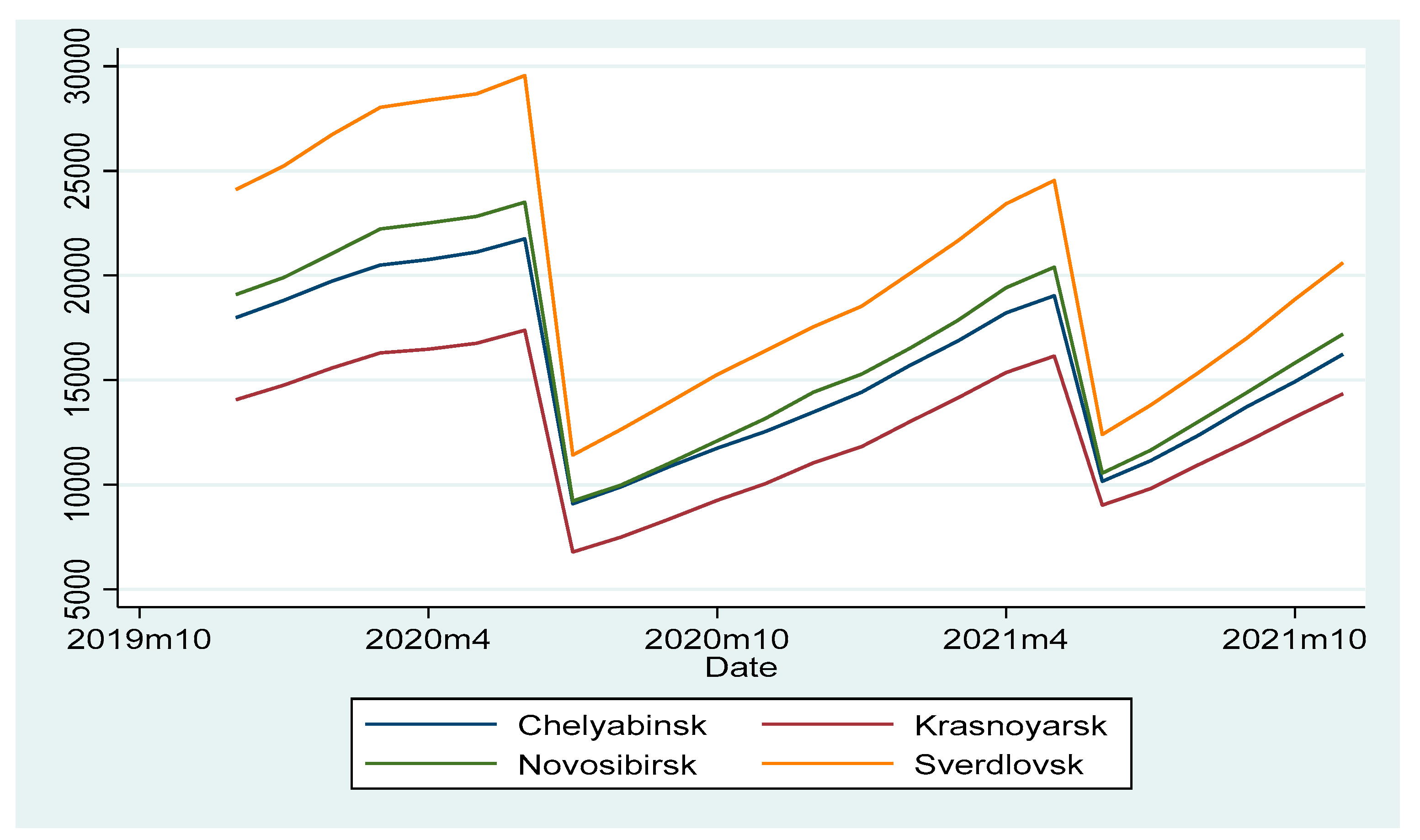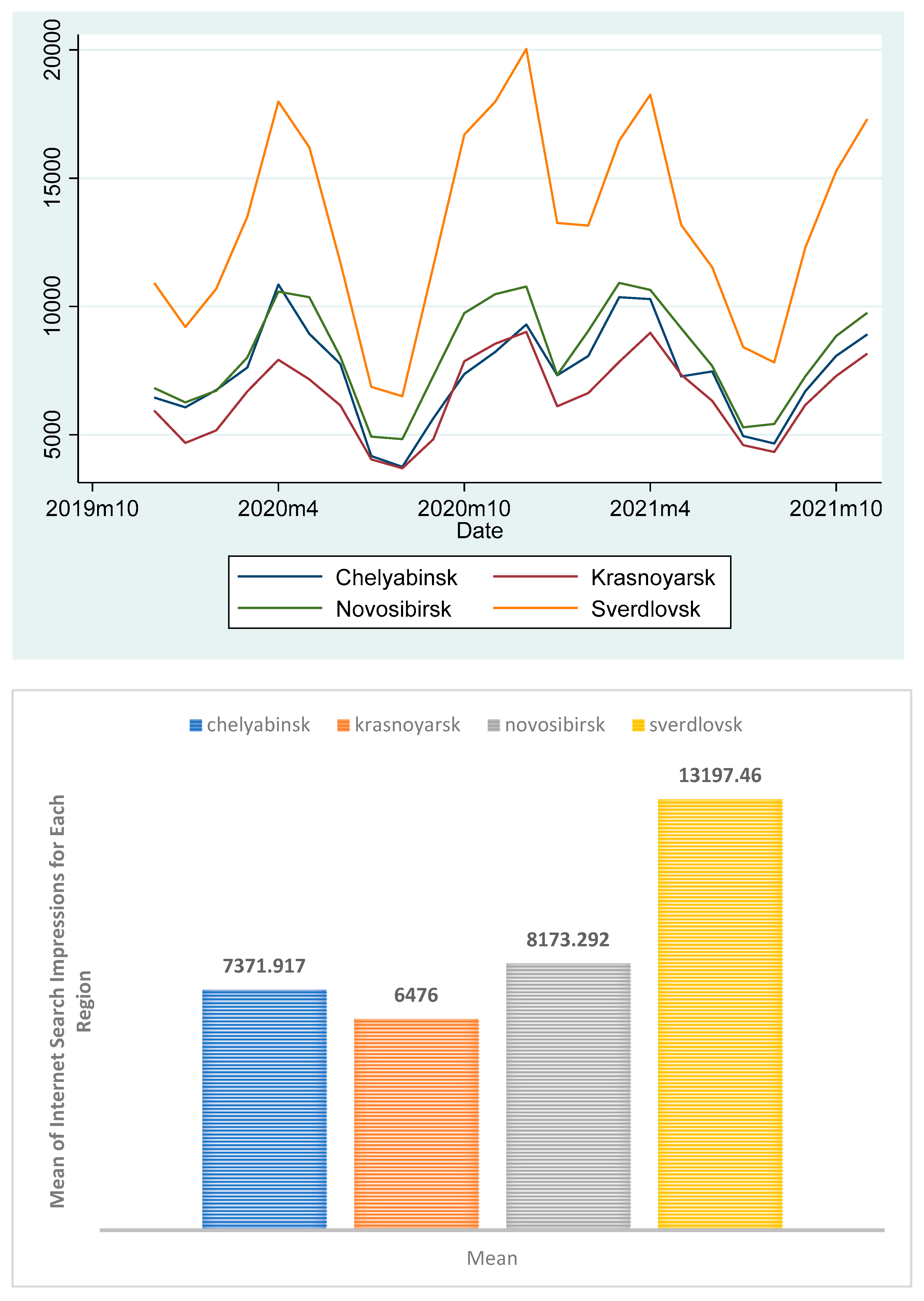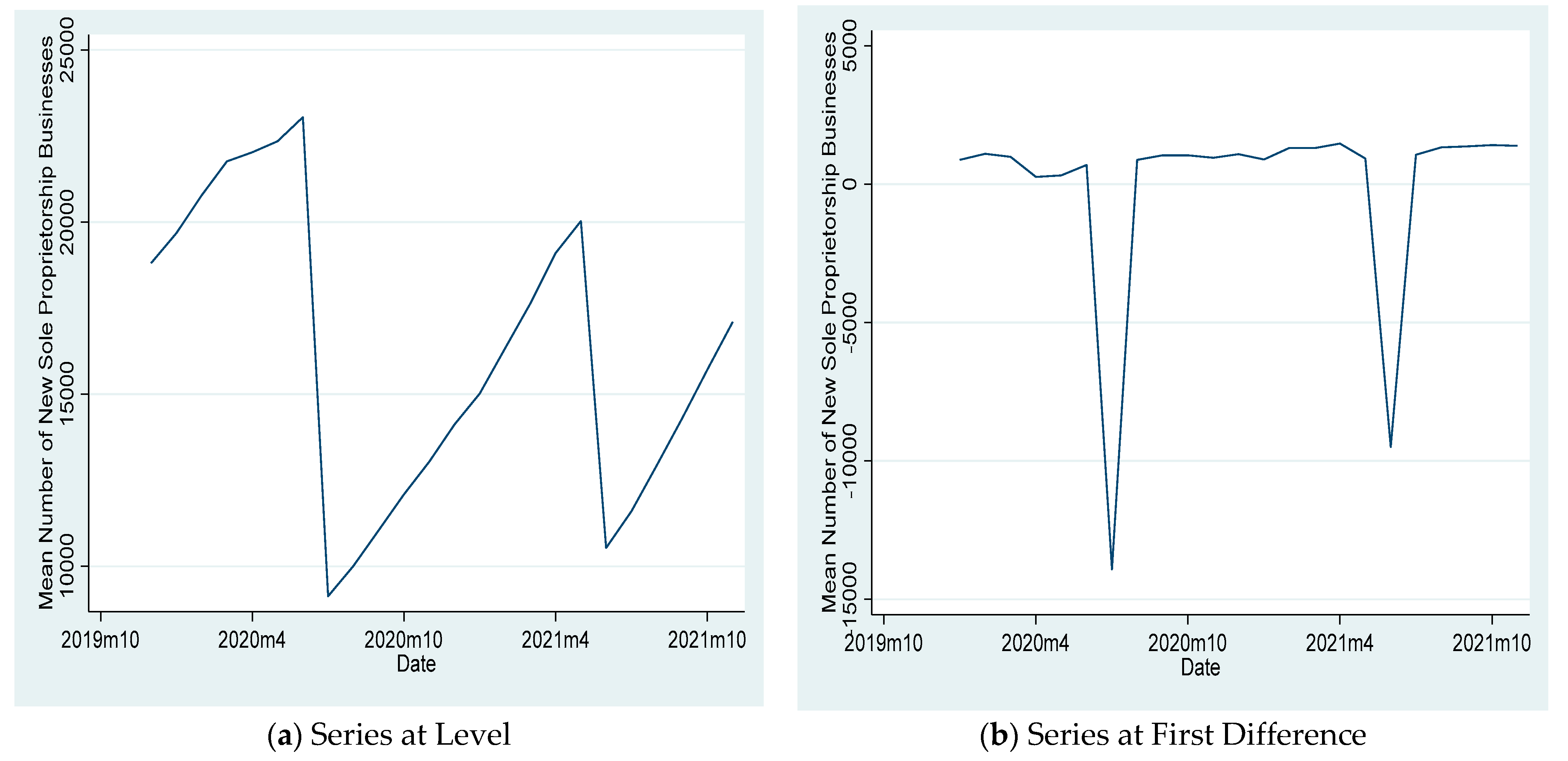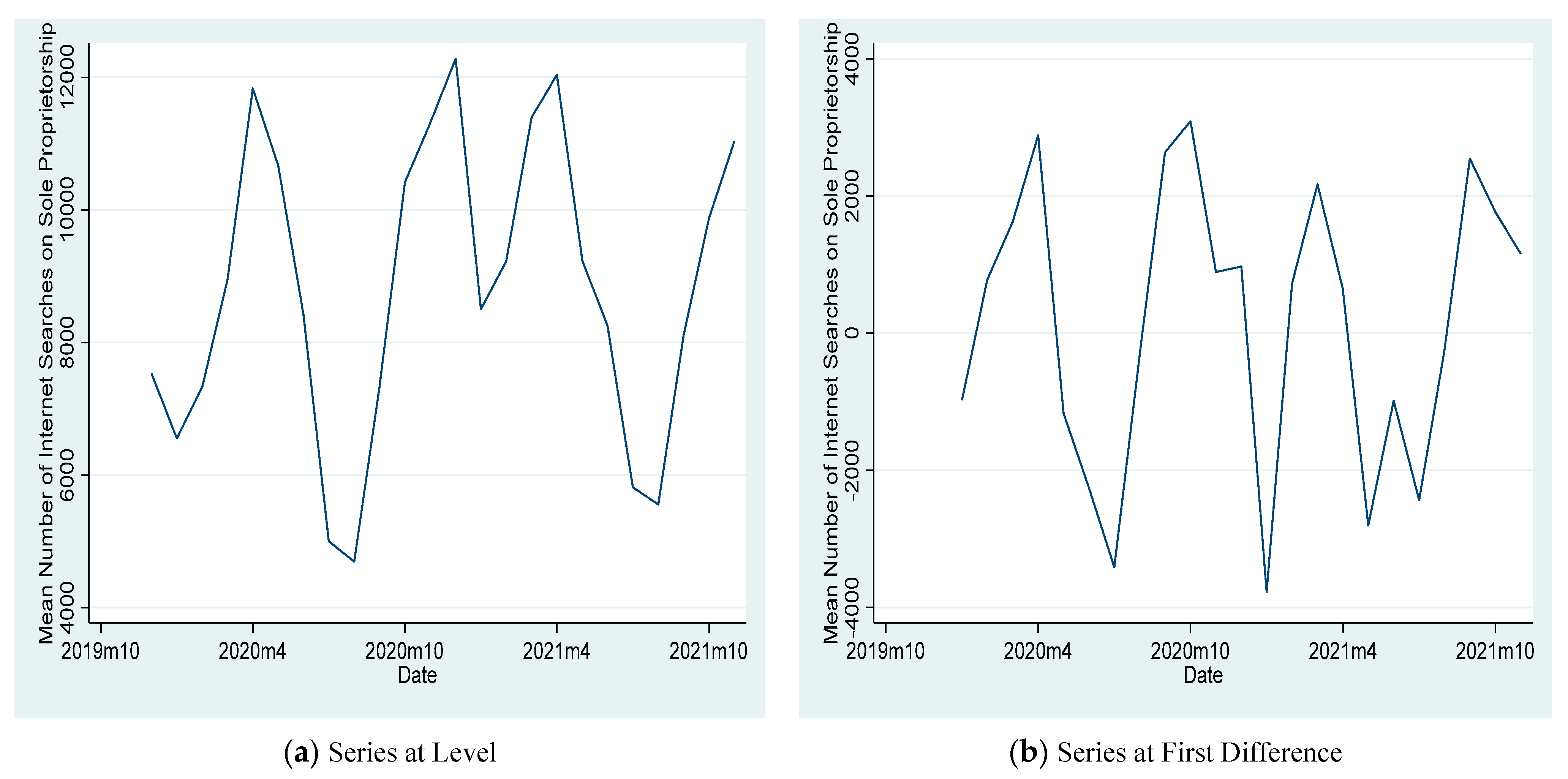The Relationship between Search Engines and Entrepreneurship Development: A Granger-VECM Approach
Abstract
1. Introduction
2. Materials and Methods
2.1. Using Search Engine Data to Measure Intention and Attention
2.2. Data Collection and Analysis
2.2.1. Unit Root Test (URT)
2.2.2. Augmented Dickey–Fuller Unit Root Test (ADF URT)
2.2.3. Cointegration Test
2.2.4. Granger Causality Test
2.2.5. Vector Error Correction Model (VECM)
3. Results
3.1. Trends and Mean
3.2. Unit Root Results
3.3. Results for Cointegration and Causality
4. Discussion
5. Conclusions
Supplementary Materials
Author Contributions
Funding
Institutional Review Board Statement
Informed Consent Statement
Data Availability Statement
Acknowledgments
Conflicts of Interest
References
- Sexton, D.L. The Field of Entrepreneurship: Is It Growing or Just Getting Bigger? J. Small Bus. Manag. 1988, 26, 4–8. [Google Scholar]
- Shane, S. Prior Knowledge and the Discovery of Entrepreneurial Opportunities. Organ. Sci. 2000, 11, 448–469. [Google Scholar] [CrossRef]
- Habert, R.F.; Link, A.N. In Search of the Meaning of Entrepreneurship. Small Bus. Econ. 1989, 1, 39–49. [Google Scholar] [CrossRef]
- Bhave, M.P. A Process Model of Entrepreneurial Venture Creation. J. Bus. Ventur. 1994, 9, 223–242. [Google Scholar] [CrossRef]
- Fritsch, M.; Mueller, P. Effects of New Business Formation on Regional Development over Time. Reg. Stud. 2004, 38, 961–975. [Google Scholar] [CrossRef]
- Fritsch, M.; Wyrwich, M. The Effect of Entrepreneurship on Economic Development—An Empirical Analysis Using Regional Entrepreneurship Culture. J. Econ. Geogr. 2017, 17, 157–189. [Google Scholar] [CrossRef]
- Baptista, R.; Escária, V.; Madruga, P. Entrepreneurship, Regional Development and Job Creation: The Case of Portugal. Small Bus. Econ. 2007, 30, 49–58. [Google Scholar] [CrossRef]
- van Stel, A.; Storey, D. The Link between Firm Births and Job Creation: Is There a Upas Tree Effect? Reg. Stud. 2004, 38, 893–909. [Google Scholar] [CrossRef]
- Malchow-Møller, N.; Schjerning, B.; Sørensen, A. Entrepreneurship, Job Creation and Wage Growth. Small Bus. Econ. 2011, 36, 15–32. [Google Scholar] [CrossRef]
- Roundy, P.T.; Fayard, D. Dynamic Capabilities and Entrepreneurial Ecosystems: The Micro-Foundations of Regional Entrepreneurship. J. Entrep. 2019, 28, 94–120. [Google Scholar] [CrossRef]
- Rogalska, E. Multiple-Criteria Analysis of Regional Entrepreneurship Conditions in Poland. Equilibrium 2018, 13, 707–723. [Google Scholar] [CrossRef]
- Content, J.; Frenken, K.; Jordaan, J.A. Does Related Variety Foster Regional Entrepreneurship? Evidence from European Regions. Reg. Stud. 2019, 53, 1531–1543. [Google Scholar] [CrossRef]
- Cumming, D.; Johan, S. The Differential Impact of the Internet on Spurring Regional Entrepreneurship. Entrep. Theory Pract. 2010, 34, 857–884. [Google Scholar] [CrossRef]
- Vlasov, M.; Polbitsyn, S.N.; Olumekor, M.; Oke, A. The Influence of Socio-Cultural Factors on Knowledge-Based Innovation and the Digital Economy. J. Open Innov. Technol. Mark. Complex. 2022, 8, 194. [Google Scholar] [CrossRef]
- Xing, Y.; Liu, Y.; Cooper, S.C.L. Local Government as Institutional Entrepreneur: Public–Private Collaborative Partnerships in Fostering Regional Entrepreneurship. Br. J. Manag. 2018, 29, 670–690. [Google Scholar] [CrossRef]
- Sternberg, R. Do EU Regional Policies Favour Regional Entrepreneurship? Empirical Evidence from Spain and Germany. Eur. Plan. Stud. 2012, 20, 583–608. [Google Scholar] [CrossRef]
- Huggins, R.; Morgan, B.; Williams, N. Regional Entrepreneurship and the Evolution of Public Policy and Governance. J. Small Bus. Enterp. Dev. 2015, 22, 473–511. [Google Scholar] [CrossRef]
- Olumekor, M. Public Sector Entrepreneurship: Scientific Mapping and Research Agenda. Organizacija 2022, 55, 259–271. [Google Scholar] [CrossRef]
- Fritsch, M.; Wyrwich, M. The Long Persistence of Regional Entrepreneurship Culture: Germany 1925–2005. SSRN Electron. J. 2012, 1224. [Google Scholar] [CrossRef]
- Tamásy, C. Determinants of Regional Entrepreneurship Dynamics in Contemporary Germany: A Conceptual and Empirical Analysis. Reg Stud. 2006, 40, 365–384. [Google Scholar] [CrossRef]
- Kim, Y.; Kim, W.; Yang, T. The Effect of the Triple Helix System and Habitat on Regional Entrepreneurship: Empirical Evidence from the U.S. Res. Policy 2012, 41, 154–166. [Google Scholar] [CrossRef]
- Olumekor, M.; Polbitsyn, S. Online Consumer Behaviour: Opportunities and Challenges for the Elderly. In Proceedings of the European Conference on Innovation and Entrepreneurship 2021, Virtual, 16–17 September 2021; pp. 1190–1195. [Google Scholar]
- Wagner, J. Nascent and Infant Entrepreneurs in Germany: Evidence from the Regional Entrepreneurship Monitor (Rem). SSRN Electron. J. 2005, 684007. [Google Scholar] [CrossRef]
- SBA. SBA Sole Proprietorship 2015; SBA: Washington, DC, USA, 2015.
- Jones, P.; Simmons, G.; Packham, G.; Beynon-Davies, P.; Pickernell, D. An Exploration of the Attitudes and Strategic Responses of Sole-Proprietor Micro-Enterprises in Adopting Information and Communication Technology. Int. Small Bus. J. Res. Entrep. 2014, 32, 285–306. [Google Scholar] [CrossRef]
- Collins-Dodd, C.; Gordon, I.M.; Smart, C. Further Evidence on the Role of Gender in Financial Performance. J. Small Bus. Manag. 2004, 42, 395–417. [Google Scholar] [CrossRef]
- Federal Tax Service Unified Register of Small and Medium-Sized Businesses 2021. Available online: https://ofd.nalog.ru/ (accessed on 15 January 2022).
- Department for Business, Energy & Induatrial Strategy. Business Population Estimates for the UK and Regions 2021: Statistical Release (HTML) 2021; Department for Business, Energy & Induatrial Strategy: London, UK, 2021.
- Pomerleau, K. An Overview of Pass-through Businesses in the United States; Tax Foundation: Washington, DC, USA, 2015. [Google Scholar]
- Cesaroni, F.M.; Sentuti, A. Access to Bank Credit during the Economic Crisis: A Comparison between Italian Male and Female Entrepreneurs. In Proceedings of the European Conference on Innovation and Entrepreneurship, Genoa, Italy, 17–18 September 2015; Volume 2015, pp. 121–129. [Google Scholar]
- Cesaroni, F.M.; Pediconi, M.G.; Sentuti, A. It’s Always a Women’s Problem! Micro-Entrepreneurs, Work-Family Balance and Economic Crisis. Adm. Sci. 2018, 8, 74. [Google Scholar] [CrossRef]
- Boden, R.J., Jr.; Nucci, A.R. On the Survival Prospects of Men’s and Women’s New Business Ventures. J. Bus. Ventur. 2000, 15, 347–362. [Google Scholar] [CrossRef]
- Cesaroni, F.M.; Sentuti, A.; Buratti, A. Same Crisis, Different Strategies? Italian Men and Women Entrepreneurs in Front of the Economic Recession. J. Res. Gend. Stud. 2015, 5, 205–231. [Google Scholar]
- Carroll, R.; Holtz-Eakin, D.; Rider, M.; Rosen, H.S. Income Taxes and Entrepreneurs’ Use of Labor. J. Labor Econ. 2000, 18, 324–351. [Google Scholar] [CrossRef]
- Power, L.; Rider, M. The Effect of Tax-Based Savings Incentives on the Self-Employed. J. Public Econ. 2002, 85, 33–52. [Google Scholar] [CrossRef]
- McKerchar, M.; Bloomquist, K.; Pope, J. Indicators of Tax Morale: An Exploratory Study. Ejournal Tax Res. 2013, 11, 5–22. [Google Scholar]
- Storey, D.J. The Role of Legal Status in Influencing Bank Financing and New Firm Growth. Appl. Econ. 1994, 26, 129–136. [Google Scholar] [CrossRef]
- Leibowitz, A.; Tollison, R. Free Riding, Shirking, and Team Production in Legal Partnerships. Econ. Inq. 1980, 18, 380–394. [Google Scholar] [CrossRef]
- Crusto, M.F. Extending the Veil to Solo Entrepreneurs: A Limited Liability Sole Proprietorship Act (LLSP). Columbia Bus. Law Rev. 2001, 2001, 381. [Google Scholar]
- Haynes, G.W.; Walker, R.; Rowe, B.R.; Hong, G.-S. The Intermingling of Business and Family Finances in Family-Owned Businesses. Fam. Bus. Rev. 1999, 12, 225–239. [Google Scholar] [CrossRef]
- Fiegener, M.K. Locus of Ownership and Family Involvement in Small Private Firms. J. Manag. Stud. 2010, 47, 296–321. [Google Scholar] [CrossRef]
- Stewart, S.A.; Hoell, R.C. Hire Someone like Me, or Hire Someone I Need: Entrepreneur Identity and Early-Stage Hiring in Small Firms. J. Small Bus. Entrep. 2016, 28, 187–201. [Google Scholar] [CrossRef]
- Toivanen, S.; Griep, R.H.; Mellner, C.; Vinberg, S.; Eloranta, S. Mortality Differences between Self-Employed and Paid Employees: A 5-Year Follow-up Study of the Working Population in Sweden. Occup. Environ. Med. 2016, 73, 627–636. [Google Scholar] [CrossRef]
- Xiao, J.J.; Alhabeeb, M.J.; Hong, G.-S.; Haynes, G.W. Attitude toward Risk and Risk-Taking Behavior of Business-Owning Families. J. Consum. Aff. 2001, 35, 307–325. [Google Scholar] [CrossRef]
- Vincent, V.C. Decision-Making Policies among Mexican-American Small Business Entrepreneurs. J. Small Bus. Manag. 1996, 34, 1. [Google Scholar]
- Ostrow, L.; Nemec, P.B.; Smith, C. Self-Employment for People with Psychiatric Disabilities: Advantages and Strategies. J. Behav. Health Serv. Res. 2019, 46, 686–696. [Google Scholar] [CrossRef]
- Baik, Y.-S.; Lee, S.-H.; Lee, C. Entrepreneurial Firms’ Choice of Ownership Forms. Int. Entrep. Manag. J. 2015, 11, 453–471. [Google Scholar] [CrossRef]
- Li, T.; Li, Y.; Hoque, M.A.; Xia, T.; Tarkoma, S.; Hui, P. To What Extent We Repeat Ourselves? Discovering Daily Activity Patterns Across Mobile App Usage. IEEE Trans Mob Comput. 2022, 21, 1492–1507. [Google Scholar] [CrossRef]
- Omar, H.; Hoang, V.H.; Liu, D.-R. A Hybrid Neural Network Model for Sales Forecasting Based on ARIMA and Search Popularity of Article Titles. Comput. Intell. Neurosci. 2016, 2016. [Google Scholar] [CrossRef] [PubMed]
- Wachter, P.; Widmer, T.; Klein, A. Predicting Automotive Sales Using Pre-Purchase Online Search Data. In Proceedings of the 2019 Federated Conference on Computer Science and Information Systems, Leipzig, Germany, 1–4 September 2019; pp. 569–577. [Google Scholar]
- Yuan, F.-C.; Lee, C.-H. Intelligent Sales Volume Forecasting Using Google Search Engine Data. Soft Comput. 2020, 24, 2033–2047. [Google Scholar] [CrossRef]
- Barreira, N.; Godinho, P.; Melo, P. Nowcasting Unemployment Rate and New Car Sales in South-Western Europe with Google Trends. NETNOMICS Econ. Res. Electron. Netw. 2013, 14, 129–165. [Google Scholar] [CrossRef]
- Li, X.; Zhang, X.; Wang, S.; Ma, J. Attention Matters: An Exploration of Relationship Between Google Search Behaviors and Crude Oil Prices. J. Syst. Sci. Complex. 2019, 32, 1438–1459. [Google Scholar] [CrossRef]
- Siliverstovs, B.; Wochner, D.S. Google Trends and Reality: Do the Proportions Match?: Appraising the Informational Value of Online Search Behavior: Evidence from Swiss Tourism Regions. J. Econ. Behav. Organ. 2018, 145, 1–23. [Google Scholar] [CrossRef]
- Höpken, W.; Eberle, T.; Fuchs, M.; Lexhagen, M. Google Trends Data for Analysing Tourists’ Online Search Behaviour and Improving Demand Forecasting: The Case of Åre, Sweden. Inf. Technol. Tour. 2019, 21, 45–62. [Google Scholar] [CrossRef]
- Markey, P.M.; Markey, C.N. Seasonal Variation in Internet Keyword Searches: A Proxy Assessment of Sex Mating Behaviors. Arch. Sex. Behav. 2013, 42, 515–521. [Google Scholar] [CrossRef]
- Gunn III, J.F.; Lester, D. Using Google Searches on the Internet to Monitor Suicidal Behavior. J. Affect. Disord. 2013, 148, 411–412. [Google Scholar] [CrossRef]
- Lippi, G.; Mattiuzzi, C.; Cervellin, G. Google Search Volume Predicts the Emergence of COVID-19 Outbreaks. Acta Biomed. 2020, 91, e2020006. [Google Scholar] [CrossRef] [PubMed]
- Abbas, M.; Morland, T.B.; Hall, E.S.; EL-Manzalawy, Y. Associations between Google Search Trends for Symptoms and COVID-19 Confirmed and Death Cases in the United States. Int. J. Environ. Res. Public Health 2021, 18, 4560. [Google Scholar] [CrossRef]
- Wang, H.-W.; Chen, D.-R. Economic Recession and Obesity-Related Internet Search Behavior in Taiwan: Analysis of Google Trends Data. JMIR Public Health Surveill 2018, 4, e7314. [Google Scholar] [CrossRef] [PubMed]
- Curme, C.; Preis, T.; Stanley, H.E.; Moat, H.S. Quantifying the Semantics of Search Behavior before Stock Market Moves. Proc. Natl. Acad Sci. USA 2014, 111, 11600–11605. [Google Scholar] [CrossRef]
- Chen, H.-Y.; Lo, T.-C. Online Search Activities and Investor Attention on Financial Markets. Asia Pac. Manag. Rev. 2019, 24, 21–26. [Google Scholar] [CrossRef]
- Takeda, F.; Wakao, T. Google Search Intensity and Its Relationship with Returns and Trading Volume of Japanese Stocks. Pac. Basin Financ. J. 2014, 27, 1–18. [Google Scholar] [CrossRef]
- Aouadi, A.; Arouri, M.; Roubaud, D. Information Demand and Stock Market Liquidity: International Evidence. Econ. Model. 2018, 70, 194–202. [Google Scholar] [CrossRef]
- Aouadi, A.; Arouri, M.; Teulon, F. Investor Attention and Stock Market Activity: Evidence from France. Econ. Model. 2013, 35, 674–681. [Google Scholar] [CrossRef]
- Bank, M.; Larch, M.; Peter, G. Google Search Volume and Its Influence on Liquidity and Returns of German Stocks. Financ. Mark. Portf. Manag. 2011, 25, 239–264. [Google Scholar] [CrossRef]
- Swamy, V.; Dharani, M.; Takeda, F. Investor Attention and Google Search Volume Index: Evidence from an Emerging Market Using Quantile Regression Analysis. Res. Int. Bus. Financ. 2019, 50, 1–17. [Google Scholar] [CrossRef]
- Tang, W.; Zhu, L. How Security Prices Respond to a Surge in Investor Attention: Evidence from Google Search of ADRs. Glob. Financ. J. 2017, 33, 38–50. [Google Scholar] [CrossRef]
- Ramos, H.P.; Ribeiro, K.K.M.; Perlin, M.S. The Forecasting Power of internet search queries in the brazilian financial market. Ram. Rev. De Adm. Mackenzie 2017, 18, 184–210. [Google Scholar] [CrossRef]
- Kim, N.; Lučivjanská, K.; Molnár, P.; Villa, R. Google Searches and Stock Market Activity: Evidence from Norway. Financ. Res. Lett. 2019, 28, 208–220. [Google Scholar] [CrossRef]
- Nguyen, D.D.; Pham, M.C. Search-Based Sentiment and Stock Market Reactions: An Empirical Evidence in Vietnam. J. Asian Financ. Econ. Bus. 2018, 5, 45–56. [Google Scholar] [CrossRef]
- Perlin, M.S.; Caldeira, J.F.; Santos, A.A.P.; Pontuschka, M. Can We Predict the Financial Markets Based on Google’s Search Queries? J. Forecast. 2017, 36, 454–467. [Google Scholar] [CrossRef]
- Olumekor, M.O.; Polo, F. Counterfactual Econometric Analysis on the Admission of Poland to the Eurozone. In Lecture Notes in Networks and Systems; Springer International Publishing: Cham, Switzerland, 2021; Volume 2, pp. 803–815. [Google Scholar]
- Choi, I. Unit Root Tests for Panel Data. J. Int. Money Financ. 2001, 20, 249–272. [Google Scholar] [CrossRef]
- Maddala, G.S.; Wu, S. A Comparative Study of Unit Root Tests with Panel Data and a New Simple Test. Oxf. Bull. Econ. Stat. 1999, 61, 631–652. [Google Scholar] [CrossRef]
- Levin, A.; Lin, C.-F.; James Chu, C.-S. Unit Root Tests in Panel Data: Asymptotic and Finite-Sample Properties. J. Econom. 2002, 108, 1–24. [Google Scholar] [CrossRef]
- Im, K.S.; Pesaran, M.H.; Shin, Y. Testing for Unit Roots in Heterogeneous Panels. J. Econom. 2003, 115, 53–74. [Google Scholar] [CrossRef]
- Johansen, S.; Juselius, K. Maximum likelihood estimation and inference on cointegration-with applications to the demand for money. Oxf. Bull. Econ. Stat. 2009, 52, 169–210. [Google Scholar] [CrossRef]
- Chan, N.H. Time Series: Applications to Finance with R and S-Plus®, 2nd ed.; John Wiley & Sons: Hoboken, NJ, USA, 2011; ISBN 9781118032466. [Google Scholar]
- Dickey, D.A.; Fuller, W.A. Distribution of the Estimators for Autoregressive Time Series With a Unit Root. J. Am. Stat. Assoc. 1979, 74, 427. [Google Scholar] [CrossRef]
- Dickey, D.A.; Fuller, W.A. Likelihood Ratio Statistics for Autoregressive Time Series with a Unit Root. Econometrica 1981, 49, 1057. [Google Scholar] [CrossRef]
- Ng, S.; Perron, P. Unit Root Tests in ARMA Models with Data-Dependent Methods for the Selection of the Truncation Lag. J. Am. Stat. Assoc. 1995, 90, 268–281. [Google Scholar] [CrossRef]
- Engle, R.F.; Granger, C.W.J. Co-Integration and Error Correction: Representation, Estimation, and Testing. Econometrica 1987, 55, 251. [Google Scholar] [CrossRef]
- Johansen, S. Statistical Analysis of Cointegration Vectors. J. Econ. Dyn. Control. 1988, 12, 231–254. [Google Scholar] [CrossRef]
- Granger, C.W.J. Investigating Causal Relations by Econometric Models and Cross-Spectral Methods. Econometrica 1969, 37, 424. [Google Scholar] [CrossRef]
- Maddala, G.S.; Kim, I.-M. Unit Roots, Cointegration, and Structural Change; Cambridge University Press: Cambridge, UK, 1999; ISBN 9780521582575. [Google Scholar]
- Wald, A. Tests of Statistical Hypotheses Concerning Several Parameters When the Number of Observations Is Large. Trans. Am. Math. Soc. 1943, 54, 426. [Google Scholar] [CrossRef]
- Prüfer, J.; Prüfer, P. Data Science for Entrepreneurship Research: Studying Demand Dynamics for Entrepreneurial Skills in the Netherlands. Small Bus. Econ. 2020, 55, 651–672. [Google Scholar] [CrossRef]
- Ortiz-Martínez, Y.; Garcia-Robledo, J.E.; Vásquez-Castañeda, D.L.; Bonilla-Aldana, D.K.; Rodriguez-Morales, A.J. Can Google® Trends Predict COVID-19 Incidence and Help Preparedness? The Situation in Colombia. Travel. Med. Infect. Dis. 2020, 37, 101703. [Google Scholar] [CrossRef]
- Walker, A.; Hopkins, C.; Surda, P. Use of Google Trends to Investigate Loss-of-smell-related Searches during the COVID-19 Outbreak. Int. Forum Allergy Rhinol. 2020, 10, 839–847. [Google Scholar] [CrossRef]
- Brodeur, A.; Clark, A.E.; Fleche, S.; Powdthavee, N. COVID-19, Lockdowns and Well-Being: Evidence from Google Trends. J. Public Econ. 2021, 193, 104346. [Google Scholar] [CrossRef] [PubMed]
- Huynh, T.L.D. Which Google Keywords Influence Entrepreneurs? Empirical Evidence from Vietnam. Asia Pac. J. Innov. Entrep. 2019, 13, 214–230. [Google Scholar] [CrossRef]




| Variable | Level (p-Value) | First Difference (p-Value) |
|---|---|---|
| New sole proprietorship businesses | 0.1359 | 0.0001 |
| Internet searches | 0.1781 | 0.0199 |
| Cointegrating Equations | ꭓ2 | p-Value |
|---|---|---|
| 1 | 34.06244 | 0.0000 |
| p-Value | |
|---|---|
| New sole proprietorship businesses do not Granger cause Internet search for sole proprietorship | 0.562 |
| Internet searches for sole proprietorship do not Granger cause new sole proprietorship businesses | 0.021 |
| Vector Error Correction Model | Coef. | Std. Err. | z | p-Value | 95% C.I. |
|---|---|---|---|---|---|
| Newly established sole proprietorships | 1 | ||||
| Internet searches for sole proprietorships | −1.516 | 0.260 | −5.84 | 0.000 | (−2.025, 1.007) |
Disclaimer/Publisher’s Note: The statements, opinions and data contained in all publications are solely those of the individual author(s) and contributor(s) and not of MDPI and/or the editor(s). MDPI and/or the editor(s) disclaim responsibility for any injury to people or property resulting from any ideas, methods, instructions or products referred to in the content. |
© 2023 by the authors. Licensee MDPI, Basel, Switzerland. This article is an open access article distributed under the terms and conditions of the Creative Commons Attribution (CC BY) license (https://creativecommons.org/licenses/by/4.0/).
Share and Cite
Olumekor, M.; Haddad, H.; Al-Ramahi, N.M. The Relationship between Search Engines and Entrepreneurship Development: A Granger-VECM Approach. Sustainability 2023, 15, 5053. https://doi.org/10.3390/su15065053
Olumekor M, Haddad H, Al-Ramahi NM. The Relationship between Search Engines and Entrepreneurship Development: A Granger-VECM Approach. Sustainability. 2023; 15(6):5053. https://doi.org/10.3390/su15065053
Chicago/Turabian StyleOlumekor, Michael, Hossam Haddad, and Nidal Mahmoud Al-Ramahi. 2023. "The Relationship between Search Engines and Entrepreneurship Development: A Granger-VECM Approach" Sustainability 15, no. 6: 5053. https://doi.org/10.3390/su15065053
APA StyleOlumekor, M., Haddad, H., & Al-Ramahi, N. M. (2023). The Relationship between Search Engines and Entrepreneurship Development: A Granger-VECM Approach. Sustainability, 15(6), 5053. https://doi.org/10.3390/su15065053





